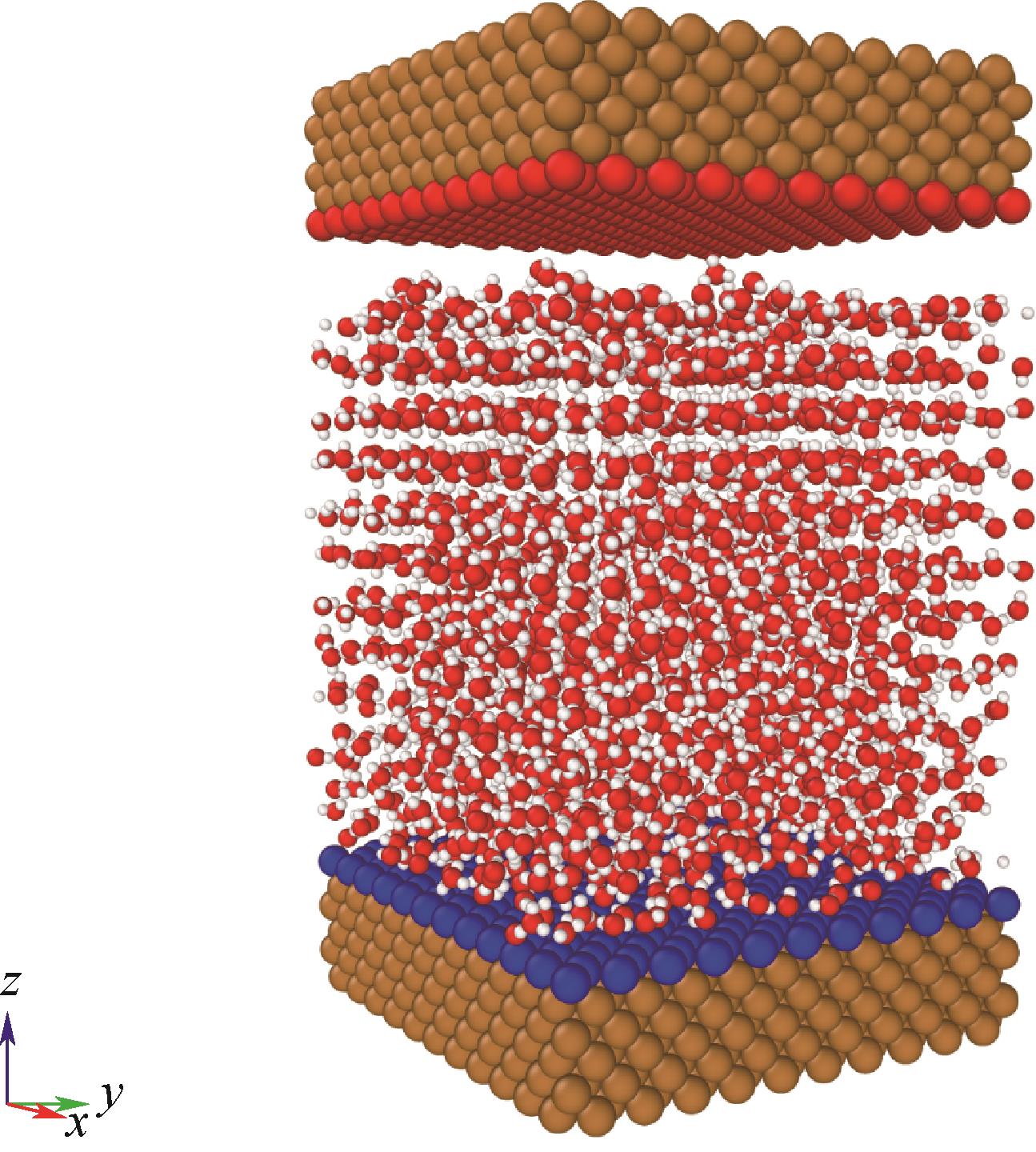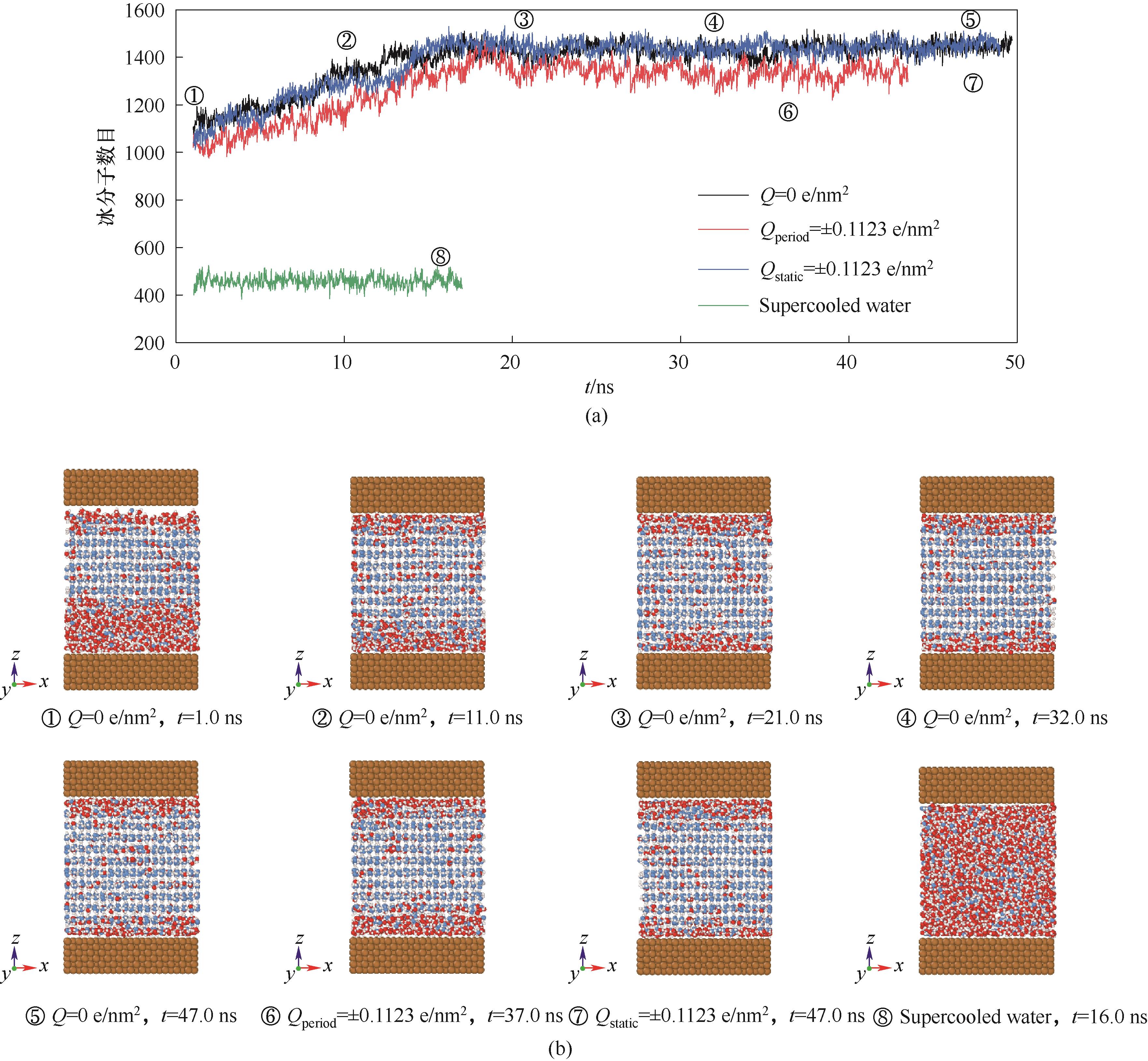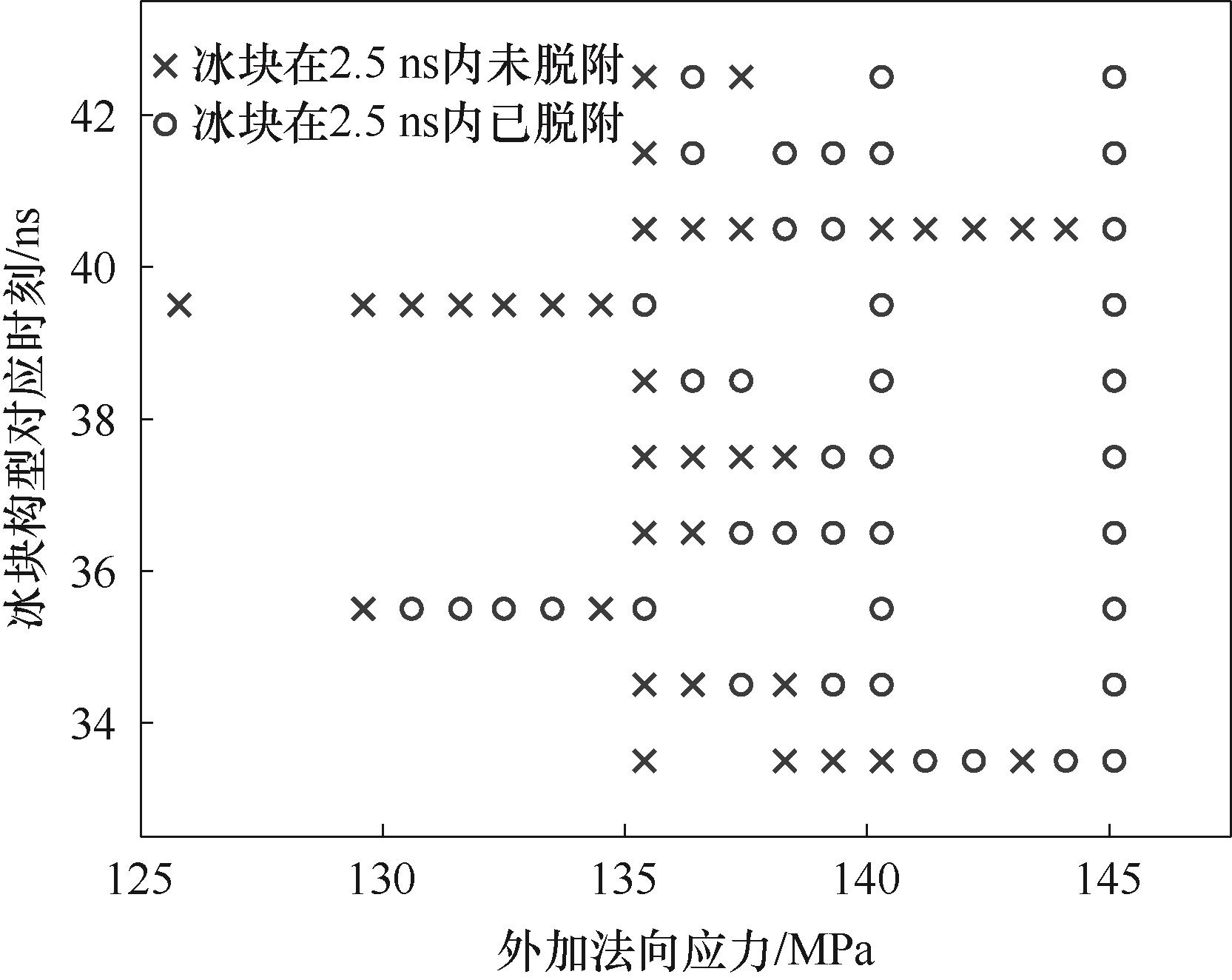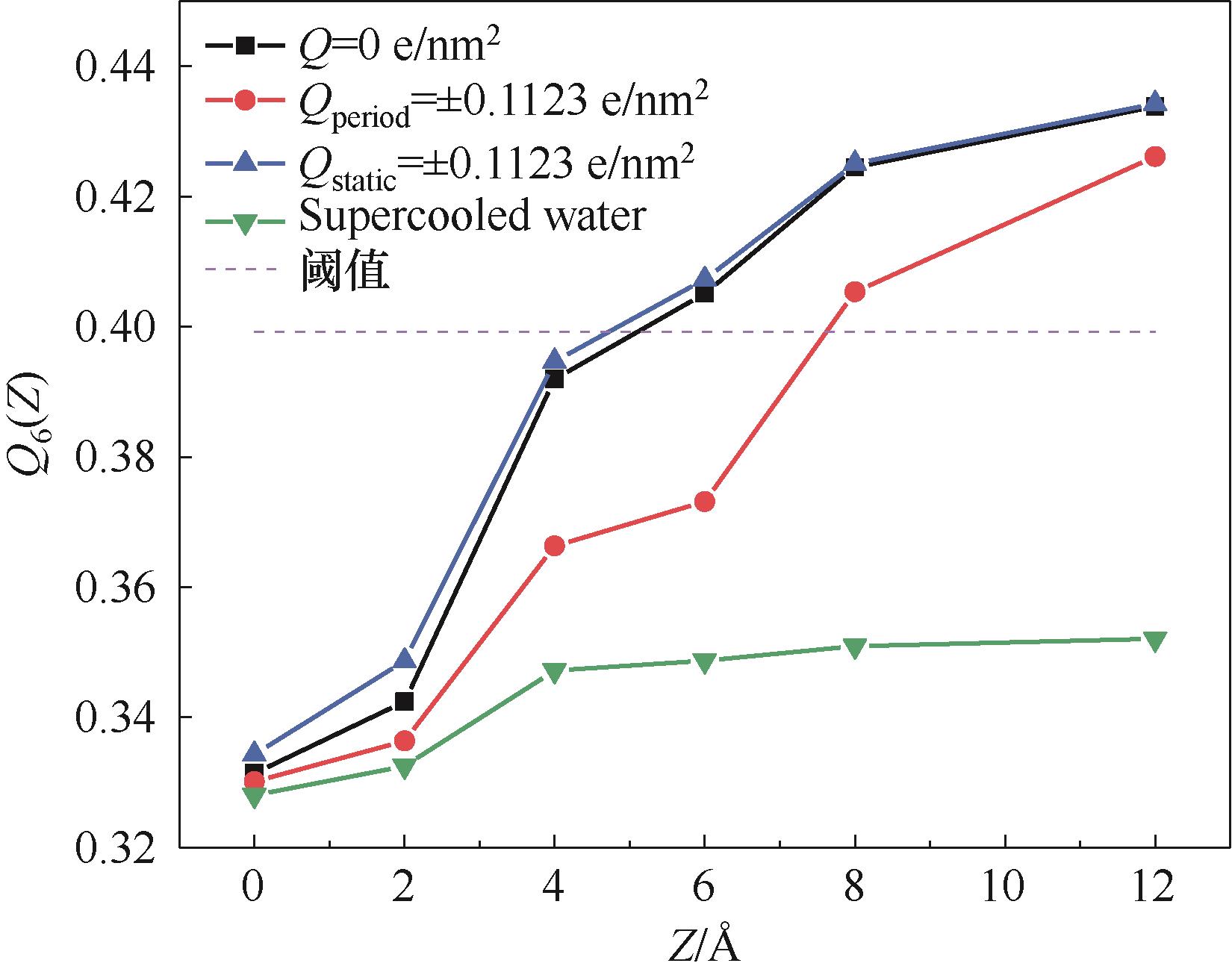化工学报 ›› 2022, Vol. 73 ›› Issue (12): 5517-5525.DOI: 10.11949/0438-1157.20221169
收稿日期:2022-08-23
修回日期:2022-11-07
出版日期:2022-12-05
发布日期:2023-01-17
通讯作者:
许雄文
作者简介:蔡文豪(1998—),男,硕士研究生,1808755506@qq.com
基金资助:
Wenhao CAI1( ), Xiongwen XU1,2(
), Xiongwen XU1,2( )
)
Received:2022-08-23
Revised:2022-11-07
Online:2022-12-05
Published:2023-01-17
Contact:
Xiongwen XU
摘要:
在过冷水式动态冰蓄冷中,低温换热表面上的冰黏附是系统稳定运行的主要威胁。研究表明,冰和换热表面的界面区域具有一层准液体层,其厚度是影响黏附强度的主要因素。壁面荷电可能增加冰的准液体层厚度,达到降低黏附强度的作用。因此,在同一水分子体系温度(T=255 K)的不同壁面荷电条件下,进行了铜壁面上黏附冰的平衡和脱附的分子动力学模拟,得到了黏附冰的准液体层厚度以及黏附强度。结果表明,相较于壁面不带电荷的工况,壁面电荷密度Qstatic=±0.1123 e/nm2且保持不变时,准液体层的厚度变化很小,冰的黏附强度由于壁面与水分子之间的库仑相互作用增强而增大;当铜壁面采用脉冲荷电Qperiod=±0.1123 e/nm2时,冰的准液体层厚度显著增加,黏附强度在可减小范围内减小31.9%。因此,壁面脉冲荷电是一种有效的降低冰黏附强度的方式。
中图分类号:
蔡文豪, 许雄文. 壁面电荷对铜表面冰黏附的影响研究[J]. 化工学报, 2022, 73(12): 5517-5525.
Wenhao CAI, Xiongwen XU. Influence of wall charge on ice adhesion on copper surface[J]. CIESC Journal, 2022, 73(12): 5517-5525.
| MO/(g/mol) | MH/(g/mol) | qO/e | qH/e | lOM/Å | r0/Å | θ0/(°) |
|---|---|---|---|---|---|---|
| 15.9994 | 1.008 | -1.1794 | 0.5897 | 0.1577 | 0.9572 | 104.5 |
表1 水分子模型参数(TIP4P/ICE)
Table 1 Model parameters of water molecule(TIP4P/ICE)
| MO/(g/mol) | MH/(g/mol) | qO/e | qH/e | lOM/Å | r0/Å | θ0/(°) |
|---|---|---|---|---|---|---|
| 15.9994 | 1.008 | -1.1794 | 0.5897 | 0.1577 | 0.9572 | 104.5 |
| 组分 | ε/(kcal/mol) | σ/Å |
|---|---|---|
| O-O | 0.2108 | 3.1668 |
| Cu-O | 0.1853 | 2.7523 |
| Cu-H, O-H, H-H | 0 | 0 |
表2 各组分之间的相互作用参数
Table 2 Interaction parameters between components
| 组分 | ε/(kcal/mol) | σ/Å |
|---|---|---|
| O-O | 0.2108 | 3.1668 |
| Cu-O | 0.1853 | 2.7523 |
| Cu-H, O-H, H-H | 0 | 0 |

图2 铜板荷电时的模型图(红色铜原子带正电荷,蓝色铜原子带负电荷)
Fig.2 Model diagram of charged copper plate (copper atoms in red are positively charged, and copper atoms in blue are negatively charged)

图6 类冰水分子数目随时间的变化及对应时刻的模型快照(黄铜色为铜原子,红色为类液水分子,蓝色为类冰水分子,白色为氢原子)
Fig.6 Time-dependent changes in the number of ice-like water molecules and model snapshots at corresponding moments (brass are copper atoms, red are “liquid” water molecules, blue are “solid” water molecules, and white are hydrogen atoms)

图7 T=255 K,Qperiod=±0.1123 e/nm2,t=33.5 ns时,不同外加法向应力下的脱附模拟中冰块质心的位置变化
Fig.7 The position change of the ice mass center in the stripping simulation under different applied normal stress when T=255 K, Qperiod=±0.1123 e/nm2,t=33.5 ns

图8 T=255 K,Qperiod=±0.1123 e/nm2,t=33.5~42.5 ns时,各个冰块构型在不同外加法向应力下的脱附情况
Fig.8 Stripping of ice under different applied normal stresses when T=255 K,Qperiod=±0.1123 e/nm2,t=33.5~42.5 ns

图10 体系平衡时的冰块静态结构(虚线为区分冰和水的阈值,虚线之上为冰,虚线之下为水)
Fig.10 The static structure of the ice cube when the system is in equilibrium (the dotted line is the threshold for distinguishing ice and water; above the dotted line is ice, and below the dotted line is water)
| 1 | Kauffeld M, Gund S. Ice slurry—history, current technologies and future developments[J]. International Journal of Refrigeration, 2019, 99: 264-271. |
| 2 | Bédécarrats J P, David T, Castaing-Lasvignottes J. Ice slurry production using supercooling phenomenon[J]. International Journal of Refrigeration, 2010, 33(1): 196-204. |
| 3 | Chen M B, Fu D K, Song W J, et al. Performance of ice generation system using supercooled water with a directed evaporating method[J]. Energies, 2021, 14(21): 7021. |
| 4 | 蔡玲玲, 米沙, 刘志强. 过冷器表面冰层分离模型研究[J]. 工程热物理学报, 2019, 40(5): 1160-1168. |
| Cai L L, Mi S, Liu Z Q. Investigation on modelling the ice separation on supercooling surface[J]. Journal of Engineering Thermophysics, 2019, 40(5): 1160-1168. | |
| 5 | Golovin K, Kobaku S P R, Lee D H, et al. Designing durable icephobic surfaces[J]. Science Advances, 2016, 2(3): e1501496. |
| 6 | Janjua Z A, Turnbull B, Choy K L, et al. Performance and durability tests of smart icephobic coatings to reduce ice adhesion[J]. Applied Surface Science, 2017, 407: 555-564. |
| 7 | Xia A N, He L, Qie S H, et al. Fabrication of an anti-icing aluminum alloy surface by combining wet etching and laser machining[J]. Applied Sciences, 2022, 12(4): 2119. |
| 8 | Carriveau R, Edrisy A, Cadieux P, et al. Ice adhesion issues in renewable energy infrastructure[J]. Journal of Adhesion Science and Technology, 2012, 26(4/5): 447-461. |
| 9 | Song M J, Deng S M, Dang C B, et al. Review on improvement for air source heat pump units during frosting and defrosting[J]. Applied Energy, 2018, 211: 1150-1170. |
| 10 | Caliskan F, Hajiyev C. A review of in-flight detection and identification of aircraft icing and reconfigurable control[J]. Progress in Aerospace Sciences, 2013, 60: 12-34. |
| 11 | Bernal J D, Fowler R H. A theory of water and ionic solution, with particular reference to hydrogen and hydroxyl ions[J]. The Journal of Chemical Physics, 1933, 1(8): 515-548. |
| 12 | Slater B, Michaelides A. Surface premelting of water ice[J]. Nature Reviews Chemistry, 2019, 3(3): 172-188. |
| 13 | Wong T S, Kang S H, Tang S K Y, et al. Bioinspired self-repairing slippery surfaces with pressure-stable omniphobicity[J]. Nature, 2011, 477(7365): 443-447. |
| 14 | Liu Q, Yang Y, Huang M, et al. Durability of a lubricant-infused electrospray silicon rubber surface as an anti-icing coating[J]. Applied Surface Science, 2015, 346: 68-76. |
| 15 | Kim P, Wong T S, Alvarenga J, et al. Liquid-infused nanostructured surfaces with extreme anti-ice and anti-frost performance[J]. ACS Nano, 2012, 6(8): 6569-6577. |
| 16 | Wang Y L, Yao X, Chen J, et al. Organogel as durable anti-icing coatings[J]. Science China Materials, 2015, 58(7): 559-565. |
| 17 | Zhu L, Xue J, Wang Y Y, et al. Ice-phobic coatings based on silicon-oil-infused polydimethylsiloxane[J]. ACS Applied Materials & Interfaces, 2013, 5(10): 4053-4062. |
| 18 | Chen J, Luo Z Q, Fan Q R, et al. Anti-ice coating inspired by ice skating[J]. Small, 2014, 10(22): 4693-4699. |
| 19 | Chen J, Dou R M, Cui D P, et al. Robust prototypical anti-icing coatings with a self-lubricating liquid water layer between ice and substrate[J]. ACS Applied Materials & Interfaces, 2013, 5(10): 4026-4030. |
| 20 | Heydari G, Tyrode E, Visnevskij C, et al. Temperature-dependent deicing properties of electrostatically anchored branched brush layers of poly(ethylene oxide)[J]. Langmuir: the ACS Journal of Surfaces and Colloids, 2016, 32(17): 4194-4202. |
| 21 | Chernyy S, Järn M, Shimizu K, et al. Superhydrophilic polyelectrolyte brush layers with imparted anti-icing properties: effect of counter ions[J]. ACS Applied Materials & Interfaces, 2014, 6(9): 6487-6496. |
| 22 | Chen D Y, Gelenter M D, Hong M, et al. Icephobic surfaces induced by interfacial nonfrozen water[J]. ACS Applied Materials & Interfaces, 2017, 9(4): 4202-4214. |
| 23 | Dou R M, Chen J, Zhang Y F, et al. Anti-icing coating with an aqueous lubricating layer[J]. ACS Applied Materials & Interfaces, 2014, 6(10): 6998-7003. |
| 24 | Zhang X X, Lv Y J, Chen M. Crystallisation of ice in charged Pt nanochannel[J]. Molecular Physics, 2013, 111(24): 3808-3814. |
| 25 | Zhu X Y, Yuan Q Z, Zhao Y P. Phase transitions of a water overlayer on charged graphene: from electromelting to electrofreezing[J]. Nanoscale, 2014, 6(10): 5432-5437. |
| 26 | Conde M M, Vega C, Patrykiejew A. The thickness of a liquid layer on the free surface of ice as obtained from computer simulation[J]. The Journal of Chemical Physics, 2008, 129(1): 014702. |
| 27 | Xiao S B, He J Y, Zhang Z L. Nanoscale deicing by molecular dynamics simulation[J]. Nanoscale, 2016, 8(30): 14625-14632. |
| 28 | Afshar A, Meng D. Adhesive shear strength of ice from nanostructured graphite surfaces by molecular dynamics simulations[EB/OL]. 2020.. |
| 29 | Meng D, Afshar A, Bassou R, et al. Molecular dynamics simulations of nano-scale icing phenomena (invited)[C]//AIAA Aviation 2020 Forum. Reston, Virginia: AIAA, 2020. |
| 30 | Thompson A P, Aktulga H M, Berger R, et al. LAMMPS—a flexible simulation tool for particle-based materials modeling at the atomic, meso, and continuum scales[J]. Computer Physics Communications, 2022, 271: 108171. |
| 31 | Stukowski A. Visualization and analysis of atomistic simulation data with OVITO—the open visualization tool[J]. Modelling and Simulation in Materials Science and Engineering, 2010, 18(1): 015012. |
| 32 | Abascal J L F, Sanz E, García Fernández R, et al. A potential model for the study of ices and amorphous water: TIP4P/Ice[J]. The Journal of Chemical Physics, 2005, 122(23): 234511. |
| 33 | Ryckaert J P, Ciccotti G, Berendsen H J C. Numerical integration of the Cartesian equations of motion of a system with constraints: molecular dynamics of n-alkanes[J]. Journal of Computational Physics, 1977, 23(3): 327-341. |
| 34 | Werder T, Walther J H, Jaffe R L, et al. On the water-carbon interaction for use in molecular dynamics simulations of graphite and carbon nanotubes[J]. The Journal of Physical Chemistry B, 2003, 107(6): 1345-1352. |
| 35 | Yu Y H, Xu X W, Liu J P, et al. The study of water wettability on solid surfaces by molecular dynamics simulation[J]. Surface Science, 2021, 714: 121916. |
| 36 | 朱丹丹, 许雄文, 刘金平, 等. 混合润湿性图案化铜基表面冷凝换热性能研究[J]. 化工学报, 2021, 72(5): 2528-2546. |
| Zhu D D, Xu X W, Liu J P, et al. Characteristic of condensation heat transfer of hybrid wettable patterned copper surfaces[J]. CIESC Journal, 2021, 72(5): 2528-2546. | |
| 37 | Boda D, Henderson D. The effects of deviations from Lorentz-Berthelot rules on the properties of a simple mixture[J]. Molecular Physics, 2008, 106(20): 2367-2370. |
| 38 | 苗瑞灿, 郭纪伟, 杨历, 等. 纳米尺度下流体剪切流动的分子动力学模拟[J]. 工程热物理学报, 2020, 41(6): 1477-1484. |
| Miao R C, Guo J W, Yang L, et al. Molecular dynamics simulation of shear flow of nanofluids in microchannels[J]. Journal of Engineering Thermophysics, 2020, 41(6): 1477-1484. | |
| 39 | Metya A, Singh J K. Nucleation of aqueous salt solutions on solid surfaces[J]. The Journal of Physical Chemistry C, 2018, 122(15): 8277-8287. |
| 40 | Yang P L, Wang Z X, Liang Z, et al. A constant potential molecular dynamics simulation study of the atomic-scale structure of water surfaces near electrodes[J]. Chinese Journal of Chemistry, 2019, 37(12): 1251-1258. |
| 41 | Wang Z X, Olmsted D L, Asta M, et al. Electric potential calculation in molecular simulation of electric double layer capacitors[J]. Journal of Physics. Condensed Matter: an Institute of Physics Journal, 2016, 28(46): 464006. |
| 42 | Steinhardt P J, Nelson D R, Ronchetti M. Bond-orientational order in liquids and glasses[J]. Physical Review B, 1983, 28(2): 784-805. |
| 43 | Lechner W, Dellago C. Accurate determination of crystal structures based on averaged local bond order parameters[J]. The Journal of Chemical Physics, 2008, 129(11): 114707. |
| 44 | Sanz E, Vega C, Espinosa J R, et al. Homogeneous ice nucleation at moderate supercooling from molecular simulation[J]. Journal of the American Chemical Society, 2013, 135(40): 15008-15017. |
| 45 | 王瑞. 冰水两相界面结构变化规律的分子动力学模拟[D]. 北京: 中国科学院大学(中国科学院过程工程研究所), 2021. |
| Wang R. MD simulations on the interfacial structure changes between ice and water[D]. Beijing: Institute of Process Engineering, Chinese Academy of Sciences, 2021. | |
| 46 | Bao L Y, Huang Z Y, Priezjev N V, et al. A significant reduction of ice adhesion on nanostructured surfaces that consist of an array of single-walled carbon nanotubes: a molecular dynamics simulation study[J]. Applied Surface Science, 2018, 437: 202-208. |
| 47 | Moore E B, Molinero V. Structural transformation in supercooled water controls the crystallization rate of ice[J]. Nature, 2011, 479(7374): 506-508. |
| [1] | 宋明昊, 赵霏, 刘淑晴, 李国选, 杨声, 雷志刚. 离子液体脱除模拟油中挥发酚的多尺度模拟与研究[J]. 化工学报, 2023, 74(9): 3654-3664. |
| [2] | 胡建波, 刘洪超, 胡齐, 黄美英, 宋先雨, 赵双良. 有机笼跨细胞膜易位行为的分子动力学模拟研究[J]. 化工学报, 2023, 74(9): 3756-3765. |
| [3] | 赵佳佳, 田世祥, 李鹏, 谢洪高. SiO2-H2O纳米流体强化煤尘润湿性的微观机理研究[J]. 化工学报, 2023, 74(9): 3931-3945. |
| [4] | 汪林正, 陆俞冰, 张睿智, 罗永浩. 基于分子动力学模拟的VOCs热氧化特性分析[J]. 化工学报, 2023, 74(8): 3242-3255. |
| [5] | 陈吉, 洪泽, 雷昭, 凌强, 赵志刚, 彭陈辉, 崔平. 基于分子动力学的焦炭溶损反应及其机理研究[J]. 化工学报, 2023, 74(7): 2935-2946. |
| [6] | 董明, 徐进良, 刘广林. 超临界水非均质特性分子动力学研究[J]. 化工学报, 2023, 74(7): 2836-2847. |
| [7] | 刘远超, 蒋旭浩, 邵钶, 徐一帆, 钟建斌, 李耑. 几何尺寸及缺陷对石墨炔纳米带热输运特性的影响[J]. 化工学报, 2023, 74(6): 2708-2716. |
| [8] | 顾浩, 张福建, 刘珍, 周文轩, 张鹏, 张忠强. 力电耦合作用下多孔石墨烯膜时间维度的脱盐性能及机理研究[J]. 化工学报, 2023, 74(5): 2067-2074. |
| [9] | 李辰鑫, 潘艳秋, 何流, 牛亚宾, 俞路. 基于碳微晶结构的炭膜模型及其气体分离模拟[J]. 化工学报, 2023, 74(5): 2057-2066. |
| [10] | 杨松涛, 李东洋, 牛玉清, 李鑫钢, 康绍辉, 李洪, 叶开凯, 周志全, 高鑫. 氟化物势能函数和热力学性质的分子模拟研究进展[J]. 化工学报, 2022, 73(9): 3828-3840. |
| [11] | 廖艺, 牛亚宾, 潘艳秋, 俞路. 复配表面活性剂对油水界面行为和性质影响的模拟研究[J]. 化工学报, 2022, 73(9): 4003-4014. |
| [12] | 郑默, 李晓霞. ReaxFF MD模拟揭示的煤热解挥发分自由基反应的竞争与协调[J]. 化工学报, 2022, 73(6): 2732-2741. |
| [13] | 李春晖, 何辉, 何明键, 张萌, 高杨, 矫彩山. 离子液体萃取硝酸中Ce(Ⅳ)的动力学研究[J]. 化工学报, 2022, 73(4): 1606-1614. |
| [14] | 王瑞, 任瑛, 陈卫, 韩永生. 冰水界面动态结构的分子动力学模拟研究[J]. 化工学报, 2022, 73(3): 1315-1323. |
| [15] | 张瑾渊, 徐娜, 贺文云, 吕耀东, 刘子璐, 张兴芳. 消防用PEO/OTAC/NaSal减阻体系的介观分子动力学分析[J]. 化工学报, 2022, 73(3): 1157-1165. |
| 阅读次数 | ||||||
|
全文 |
|
|||||
|
摘要 |
|
|||||
 京公网安备 11010102001995号
京公网安备 11010102001995号